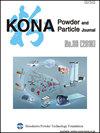流化床工艺制备赤铁矿微颗粒及纳米颗粒的机理研究
IF 3.2
4区 材料科学
Q3 ENGINEERING, CHEMICAL
引用次数: 1
摘要
研究了一种连续、紧凑、简单的合成氧化铁微粒和纳米颗粒的工艺。该工艺结合了在含有粗粒和热玻璃珠(T = 200°C)的流化床反应器中喷射(粉碎)硝酸铁的溶液,用于生产固体和用于煅烧的输送床反应器(T = 490°C)。在流化床反应器中形成的中间产物是二线水合铁,而煅烧反应器可以生产赤铁矿微颗粒和纳米颗粒。颗粒粒径分布较窄,平均粒径为0.5 μm,比表面积为24 m 2 g -1,密度为4499 kg m -3。颗粒由小簇晶组成,平均尺寸为47 nm,内部孔隙率低(0.12)。利用马弗炉和实验室对流干燥机对反应机理进行了研究。研究发现,在除去溶液水后,首先要经过几个步骤才能产生二水合硝酸铁,以及两分子和五分子的水合水。之后,硝酸盐的消除导致水合铁的产生。最后,水合铁通过去除残余硝酸盐和羟基化水转化为赤铁矿。本文章由计算机程序翻译,如有差异,请以英文原文为准。
Production of Hematite Micro- and Nanoparticles in a Fluidized Bed Process—Mechanism Study
A continuous, compact and simple process was developed to synthesize micro- and nanoparticles of iron oxide. The process combines the spraying (pulverization) of an aqueous solution of iron nitrate in a fluidized bed reactor containing coarse and hot glass beads ( T = 200 °C) for the production of solids and a transported bed reactor for calcination ( T = 490 °C). The intermediate product formed in the fluidized bed reactor is 2-line ferrihydrite, while the calcination reactor allows the production of hematite micro- and nanoparticles. These particles are characterized by a narrow size distribution, a mean size of 0.5 μm, a specific surface area of 24 m 2 g –1 and a density of 4499 kg m –3 . Particles are made up of small clusters of crystallites having an average size of 47 nm and a low internal porosity (0.12). The reaction mechanism was studied using a muffle furnace and a lab convective dryer. It was found that several steps are involved leading first to the production of iron nitrate dihydrate after the removal of the solution water, as well as two and then five molecules of water of hydration. After that, the elimination of nitrate leads to the production of ferrihydrite. Finally, ferrihydrite is transformed into hematite due to the removal of residual nitrate and water of hydroxylation.
求助全文
通过发布文献求助,成功后即可免费获取论文全文。
去求助
来源期刊

KONA Powder and Particle Journal
工程技术-材料科学:综合
CiteScore
8.40
自引率
4.90%
发文量
35
审稿时长
>12 weeks
期刊介绍:
KONA publishes papers in the broad field of powder science and technology, ranging from fundamental principles to practical applications. Papers describing technological experience and critical reviews of existing knowledge in special areas are also welcome.
 求助内容:
求助内容: 应助结果提醒方式:
应助结果提醒方式:


